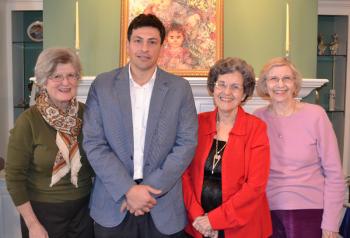
THE POST-SIGNAL / Saja Hoffpauir
C. Keagan LeJeune, Ph.D., a folklorist and an associate professor in the Department of Languages at McNeese State University, second from left, was the guest speaker at the February meeting of the Attakapas Study Club. Welcoming him were the meeting’s hostesses, from left, Roy Lynn Trahan, Shirley Griffin and Ella Bertrand.
Folklore professor addresses Attakapas Study Club
The Attakapas Study Club of Crowley met on Wednesday, Feb. 12, at the home of Roy Lynn Trahan.
There were 14 members and three guests present. Members present were Ella Bertrand, Erma Breaux, Jackie Buescher, Jerrie Fontenot, Shirley Griffin, Barbara Lengefeld, Bonnie Matirne, Gerry Meche, Jean Oubre, Joanna Pruitt, Dot Simon, Jeri Stevenson, Ethel Thibodeaux and Trahan. The guests were Jackie Keyes, Sydna Hanks and the guest speaker.
The president, Trahan, called the meeting to order and introduced C. Keagan LeJeune, Ph.D., the guest speaker for the day.
Dr. LeJeune is an associate professor in the Department of Languages at McNeese State University and specializes in folklore. He has authored numerous articles and projects, and at least one book, “Always for the Underdog: Leather Britches Smith and the Grabow War.” He delighted the members by speaking about the “Myths and Legends Byway,” a 150-mile-long route steeped in the myths, legends and folklore of Allen, Beauregard and Vernon parishes.
Vernon related that the route begins near the Texas state line in Southwest Louisiana and travels through what was historically known as “no man’s land,” or the “neutral strip” – an area associated with stories of buried treasures, money trees, outlaws, Indians, river pirates, military maneuvers and booming sawmill towns. The route encourages people to get off the beaten path and to explore the history of the area.
Attractions along the route include old cemeteries, historic buildings, Civil War sites, sawmill towns, a jail, forests, farmers markets and wildlife viewing. This state project is designed to promote rural tourism in the area.
This byway is also intended to explore the culture of the area, especially intangible culture such as song, music, drama, skills, cuisine, annual festivals, crafts and the other parts of culture that can be recorded but cannot be touched or interacted with easily.
Particularly interesting were LeJeune’s tales about the Gothic Beauregard Parish Jail (also called “the hanging jail”), which was completed in about 1914 and located in DeRidder. Those who planned the building wanted it to symbolize the progress and stability in the newly formed parish. The jail is likely the only Gothic style jail built in this era in the country. It had roomy cells, each having a window, toilet, shower and lavatory – luxuries that most people lacked at the time. Many joked it was more of “a clubhouse than a jailhouse.”
The city of DeRidder and its Gothic jail sit right in the middle of Lousiana’s “no man’s land,” which region briefly served as an official neutral buffer between Spain and the United States. The two nations created the buffer to prevent war and declared it officially “neutral,” which meant that neither nation’s troops would patrol it.
Unfortunately, because it lacked protection from any military forces, Louisiana’s “neutral strip” quickly became a lawless area. A lumber boom in the late 1800s brought in rough and rowdy workers.
One very notable outlaw from Texas, Charles “Leather Britches” Smith, became prominent in the area. Some of the working class saw him as a sort of folk hero, while those who owned mills and businesses felt he was a criminal. The long-standing residents and sawmill owners who wanted law and order and a quiet God-fearing life probably worked hard to rid the area of such outlaws, as well as other roughnecks, vagabonds and criminals. Finally, land was donated by lumber companies and the jail was built to symbolize the rowdy days as a neutral zone were over.
Many other topics were explored and included such highlights as the explanation about cemetery gravehouses in the area, as well as the stories about circuit riders like Joseph Willis (Father Willis), the first Baptist preacher to preach west of the Mississippi, riding about the countryside with a few meager possessions.
Following the presentation, LeJeune answered questions from the members and Trahan thanked him for coming and presented him with a small gift.
The business session of the meeting was held after the program, and the meeting concluded with refreshments served by hostesses, Trahan, Bertrand and Griffin.
- Log in to post comments
